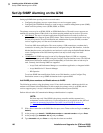
3
Installing a New G700 with an S8300
Set Up SNMP Alarming on the G700
166 Installation and Upgrades for G700 and S8300
December 2003
Set Up SNMP Alarming on the G700
Setting up SNMP alarm reporting involves two main tasks:
• Configuring the primary server to report alarms to a services support agency
• Configuring the G700 Media Gateway to send its traps to a network management system (NMS),
which can be the primary server (S8300, S8500, or S8700).
The primary server may be an S8300, S8500, or S8700 Media Server. The media server supports two
methods for reporting alarms. Either, both, or no alarm-reporting method may be used at a given site.
• OSS Method. The server’s software applications and hardware devices under its control can
generate Operations Support System (OSS) alarms. These alarms are recorded in the server logs,
and may be reported to Avaya’s Initialization and Administration System (INADS) or another
services support agency over the server’s modem interface.
To activate OSS alarm notification: The server requires a USB connection to a modem that is
connected to an analog line. The modem must be configured using the Web Interface, in the Set
Modem Interface screen, and enabled to send and receive calls using the Enable/Disable Modem
screen. Configuration of the OSS alarming method can only be done using Linux shell
commands.
• SNMP Method. SNMP traps may be sent in User Datagram Protocol (UDP) to a corporate
network management system (NMS) using the Configure Trap Destinations screen. The OSS and
SNMP alarm-notification methods operate independently of each other; either or both may be
used. Currently, the following NMSs are supported:
— Avaya Fault and Performance Manager, as a standalone application, or integrated within
— Avaya MultiService™ Network Manager
— HP Openview
To activate SNMP alarm notification: On the server Web Interface, use the Configure Trap
Destinations screen to set up SNMP destinations in the corporate NMS.
Add INADS phone numbers and Enable alarms to INADS
The following procedure, using the primary server’s Linux shell commands, administers the dial-out
modem to send alarms in the OSS method. In this example, the primary server is an S8300, and the
services support agency is Avaya’s Initialization and Administration System (INADS).
Perform this task after all Communication Manager administration is complete.
NOTE:
Do these steps only if the S8300 is the primary controller and the customer has a
maintenance contract with Avaya. Use the information you acquired from the ART tool
(see Run the Automatic Registration Tool (ART) for the INADS IP Address, if
Necessary). Also, a USB modem must have already been installed.
1 With a direct connection to the S8300 Services port, start a Telnet session and log in as craft (or
dadmin)
.
2 At the prompt, type almcall -f INADS phone number -s <second-number> and press Enter.
3 At the prompt, type almenable -d b -s y and press Enter.
4 Type almenable and press Enter to verify that the alarms are enabled.


















